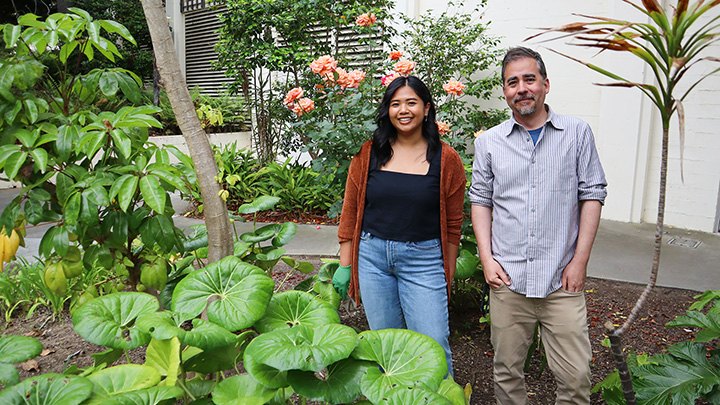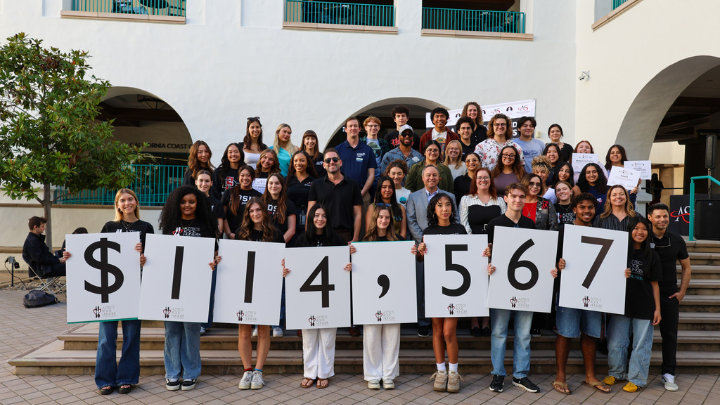Gut health discovery made using microscopic worms — found close at hand
Robert Luallen’s biology lab turns to nematodes to understand complex gut microbiome issues

Using tiny, transparent worms found in a garden a short stroll from their lab, San Diego State University researchers made a discovery that could help improve treatment of gut health issues.
Intestines are an intricate system of twisting and turning tubes covered in a mucus layer, home to thousands of different kinds of bacteria. This makes it difficult to pinpoint specific bacteria and identify which are associated with such gastrointestinal (GI) diseases as Crohn’s disease, inflammatory bowel disease and even colorectal cancer, which impact tens of millions of Americans.
In a study published in May in the Nature journal npj Biofilms and Microbiomes, Robert Luallen, associate professor of biology, and his team of researchers in the Life Sciences North Luallen Lab worked with French researchers supported by the CNRS and Université de Rennes. They discovered three species of bacteria that anchor onto a mucus layer covering the intestines instead of floating freely before being flushed out during digestion.
These bacteria were found inside Caenorhabditis elegans, a microscopic nematode with intestinal cells similar to those found in the human gut, that help decompose dead vegetation.
Because they cling to the intestinal cells, these bacteria are not easily cleared out of the gut and can quickly grow and replicate throughout the whole system. Surprisingly, though, the researchers found one of these bacterial species is commensal, meaning it has no negative effect on the worms.
“We knew pathogens can chew through the mucus layer, attach to cells, then infect the cells, but this is probably the first direct evidence in any animal that a commensal bacteria is actually binding to intestinal cells in the gut,” Luallen said. “Within 48 hours, the bacteria have established themselves in the entire intestine.”
Health issues
These findings could offer key implications for remedying gut health issues, which occur when pathogenic bacteria outnumber commensal or beneficial bacteria, a phenomenon called dysbiosis. Identifying the mechanisms allowing commensal bacteria to latch onto intestinal cells could enable scientists to remove these mechanisms from pathogenic bacteria or give patients beneficial bacteria to overthrow invading pathogens.
“If we can understand how commensal bacteria are capable of successfully establishing in the gut and identify the bacteria associated with a healthy microbiome, then there's the possibility that you could engineer those bacteria to better attach in somebody with a disease,” Luallen said.
“You could essentially choose your own microbiome and that could lend itself to the discovery of therapeutics to alleviate some of the gut dysbiosis we see,” said Dalaena Rivera, who has dedicated the past six years to this project and graduated from the joint doctoral program in cell and molecular biology earlier this year.
The research team also explored whether commensal bacteria alone could protect against invading pathogens.
“It's like San Diego — all the good real estate has been taken so finding an open space to establish yourself is really difficult,” Luallen said. “We found that when we flood the entire gut of the worm with commensal bacteria, they take all the good real estate. Then when we flow the pathogen in, it has a much harder time establishing itself in the host.”
As Luallen explained, there are existing methods aimed at promoting a healthy gut but none are as optimal as microbiome-based therapies could be. For one, probiotics, while beneficial, do not replace bad bacteria or establish themselves throughout the gut enough to change the microbiome and completely resolve issues.
“The only way to really successfully transfer microbiome bacteria in humans is fecal transplantation, which is gross,” Luallen said. “So once we understand how commensals are able to successfully establish in the host, rather than having to treat someone with antibiotics and then give them a new microbiome, you engineer bacteria to be better at establishing and when they get in the gut, they will out-compete the existing microbiome.”
The team also observed intriguing results when feeding the worms a mix of commensal and pathogenic bacteria. Instead of one type of bacteria dominating, the bacteria migrated to different parts of the worm gut, balancing each other out.
The team suggests that, down the line, treating people with similar peacemaking bacteria could be another effective therapy for GI issues.



